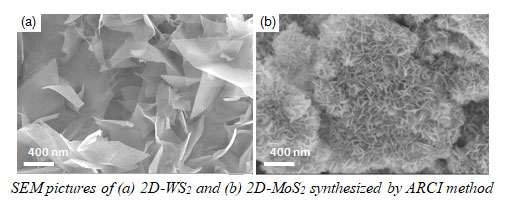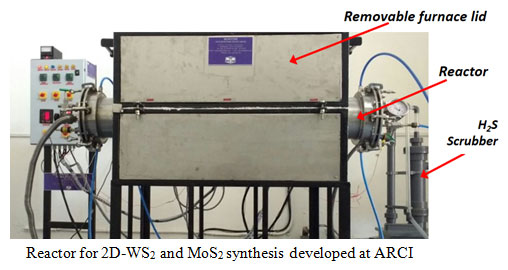 Scientists at the International Advanced Research Centre for Powder Metallurgy and New Materials (ARCI), an autonomous R&D Centre of Department of Science and Technology (DST), have developed an improved and commercially viable synthesis route for two-dimensional tungsten disulfide used in photocatalysts for hydrogen evolution reaction and petrochemical catalyst. These materials are potential candidates for applications in field emission tunneling transistors, Li-ion battery electrodes, and lubricants.
Scientists at the International Advanced Research Centre for Powder Metallurgy and New Materials (ARCI), an autonomous R&D Centre of Department of Science and Technology (DST), have developed an improved and commercially viable synthesis route for two-dimensional tungsten disulfide used in photocatalysts for hydrogen evolution reaction and petrochemical catalyst. These materials are potential candidates for applications in field emission tunneling transistors, Li-ion battery electrodes, and lubricants.
Two-dimensional tungsten disulfide or 2D-WS2 has extremely low coefficient-of-friction, and this makes it a solid lubricant under high shear load in forging as well as an effective additive to automotive lubricant oil and extreme performance grease. Such remarkable range of properties and potential applications has triggered worldwide efforts, in recent years, to develop new synthesis techniques that are efficient, cost-effective, and capable of producing 2D-WS2 in bulk quantities and reproducible quality. But most of the known methods for the generation of 2D-WS2 either produce minuscule amounts of the product or involves high cost or lack reproducible quality.
 The ARCI team developed a novel synthesis method based on a controlled temperature and pressure approach. The method showed excellent capability in the bulk synthesis of 2D WS2 and other chalcogenides like Molybdenum disulfide (MoS2). The team observed microstructure of the synthesized 2D-WS2 and 2D-MoS2 particles under a scanning electron microscope and found that the material had a high surface area of about 50 to 250 m2/g. The high surface area in these grades of powders contributes to their properties and performance.
The ARCI team developed a novel synthesis method based on a controlled temperature and pressure approach. The method showed excellent capability in the bulk synthesis of 2D WS2 and other chalcogenides like Molybdenum disulfide (MoS2). The team observed microstructure of the synthesized 2D-WS2 and 2D-MoS2 particles under a scanning electron microscope and found that the material had a high surface area of about 50 to 250 m2/g. The high surface area in these grades of powders contributes to their properties and performance.
The method is cost-effective as it uses cheap raw material in the form of metal oxide powders and makes use of various commercially viable bulk production routes for nano-precursor production, like high energy ball milling and wet-chemical methods.
Further, large scale synthesis of WS2 and MoS2 nanosheet powder (few kilograms) by the ARCI method was successfully demonstrated using a scaled-up reactor. A pilot-scale reactor with a production capacity of up to 2 kg/day (0.5 kg/batch), has also been designed and developed indigenously as part of a project sponsored by Hindustan Petrochemicals Limited. Further work is in progress to evolve commercial applications in the area of lubrication and catalysis.
For more details contact Dr. Joydip Joardar (joydip[at]arci[dot]res[dot]in)






























